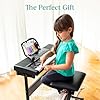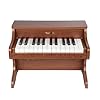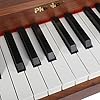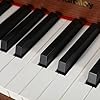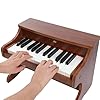Table of Contents
Introduction to Learning Piano
Embarking on the journey of learning the piano can be exhilarating, even if you have no prior music experience. This guide is designed to assist absolute beginners in overcoming the challenges associated with starting piano lessons from scratch. You will discover the essentials of piano theory, practical tips on technique, and smart strategies to efficiently learn piano. Whether your goal is to play classical pieces, contemporary songs, or even compose your own music, this introductory guide sets the foundation for a rewarding musical expedition.
Understanding the Basics of Musical Notation
The staff consists of five lines and four spaces, each representing a different musical pitch. Notes are placed on the lines and spaces to indicate their pitch, with higher notes placed higher on the staff.
Best Choice Products 61-Key Electronic Keyboard Piano Portable Electric Keyboard Complete Beginner Set w/LED Screen, Stand, Bench, Headphones - Black
20% OffDonner 61 Key Keyboard Piano, Electric Piano Keyboard Kit with 249 Voices, 249 Rhythms - Includes Piano Stand, Stool, Microphone, Gift for Beginners, Black (DEK-610S)
33% OffPLAMILOY Kids Piano 25-Key, Toddler Musical Keyboard Toy, Portable Wooden Electronic Keyboard for 3 Ages+, Educational Learning Gift for Boys & Girls
$89.99 (as of December 13, 2025 11:40 GMT -08:00 - More infoProduct prices and availability are accurate as of the date/time indicated and are subject to change. Any price and availability information displayed on [relevant Amazon Site(s), as applicable] at the time of purchase will apply to the purchase of this product.)The 23 Greatest Solo Piano Works
12% OffClefs are symbols at the beginning of the staff that designate the pitch of the notes. The two most common clefs used in piano music are the Treble Clef and the Bass Clef. The Treble Clef generally indicates higher notes, typically played with the right hand, while the Bass Clef indicates lower notes, typically played with the left hand.
Notes represent the pitch and duration of a sound, while rests represent silence. Each type of note (whole, half, quarter, eighth, and sixteenth) has a corresponding rest with the same duration of silence. Understanding these symbols is crucial for reading music.
Time signatures appear at the beginning of a piece of music, right after the clef. They consist of two numbers stacked on top of each other. The top number indicates how many beats are in each measure, while the bottom number indicates the note value that represents one beat. Common time signatures include 4/4, 3/4, and 6/8.
Key signatures indicate the key of the piece by specifying which notes are to be played sharp or flat throughout the piece. They appear right after the clef and before the time signature. Understanding the key signature helps you identify which notes will be consistently altered.
Beginner Piano Book for Kids | Piano Lessons | Learn to Play Your First Songs | Intro to Piano
$10.97 (as of December 13, 2025 23:10 GMT -08:00 - More infoProduct prices and availability are accurate as of the date/time indicated and are subject to change. Any price and availability information displayed on [relevant Amazon Site(s), as applicable] at the time of purchase will apply to the purchase of this product.)How to Train Your Dragon - Motion Picture Soundtrack Music | Piano Solo Songbook for Keyboard | 14 Oscar-Nominated John Powell Piano Arrangements from Dreamworks Movies | Celtic-Inspired
5% OffPiano: Learn The Piano in 5 Easy Steps: A Self-Guided Piano Course for Beginners (with Online Video Instruction - Piano Learning Books for Beginning Piano Players)
17% Off120 Famous Easy Piano Songs for Beginners: Popular Sheet Music and Simplified Classical Pieces, With Videos, Music Theory & Technique, Step by Step, for Kids or Amateurs of Any Age
$9.99 (as of December 13, 2025 23:19 GMT -08:00 - More infoProduct prices and availability are accurate as of the date/time indicated and are subject to change. Any price and availability information displayed on [relevant Amazon Site(s), as applicable] at the time of purchase will apply to the purchase of this product.)Dynamics indicate the volume of the music, ranging from very soft to very loud. Common dynamic markings include piano (p) for soft, mezzo-piano (mp) for moderately soft, mezzo-forte (mf) for moderately loud, and forte (f) for loud. Composers use these markings to convey the emotional intensity of the piece.
Articulations give instructions on how to play individual notes or passages. Common articulations include staccato (short and detached), legato (smooth and connected), and accents (emphasizing certain notes). Proper articulation can make a significant difference in the expressiveness of your playing.
Tempo markings specify the speed at which a piece should be played. They are often given in beats per minute (BPM) or using descriptive Italian terms such as Allegro (fast), Adagio (slow), and Moderato (moderate). Knowing the tempo is essential for maintaining the correct flow and rhythm of the music.
Simple Exercises to Build Finger Strength and Dexterity
Finger Tapping Practice
Sit with a relaxed posture at the piano and place your fingers on the keys. Start by tapping each finger individually on its designated key. Begin with your thumb and work your way to your pinky, then go back in reverse order. This helps in developing individual finger strength and increasing overall control.
Five-Finger Scales
Play five-note scales with your right and left hands separately. Begin with C major (C, D, E, F, G) and advance to other scales. Play each note clearly and evenly, ensuring that all fingers participate equally. Focus on playing slowly and accurately before increasing tempo. This builds both strength and coordination.
Finger Lifts
Place your fingers on the keys and gently lift each finger one by one, as high as comfortably possible, while keeping the others in contact with the keys. This exercise helps in strengthening the muscles responsible for lifting and controlling the fingers, thus enhancing dexterity and independence.
Hanon Exercises
Practice Hanon exercises designed specifically for finger strength and agility. These exercises involve repetitive finger movements and patterns that promote a more balanced strength across all fingers. Begin with the first few exercises in the Hanon series and gradually increase complexity as you progress. Consistency in practicing Hanon exercises leads to improved finger control and endurance.
Playing on Tabletop
When away from the piano, practice finger movements by placing your hands on a tabletop and mimicking playing motions. Tap your fingers in various sequences, ensuring each tap is controlled. This exercise is useful for maintaining and building finger strength even when a piano isn’t accessible, promoting muscle memory.
Trill Exercise
Focus on two adjacent fingers at a time (e.g., index and middle finger). Alternate pressing down on a key with each finger rapidly. Start slow and gradually speed up as you gain control. This exercise helps in building the rapid movement and coordination required for more advanced pieces.
Finger Stretches
To prevent muscle tightness and enhance flexibility, incorporate finger stretching exercises. Gently stretch each finger by pulling it back towards your wrist, holding for a few seconds. Rotate stretches across all fingers. This promotes flexibility and helps in reducing the risk of strain from repetitive playing.
Learning to Play Songs Using Just One Hand
Starting your piano learning journey by focusing on one hand, typically the right hand, is a practical approach that simplifies the learning process. Here’s how to effectively master songs with one hand:
Begin by familiarizing yourself with the layout of the piano keys. Spend some time each day identifying notes and their respective keys to build muscle memory. Practice simple scales such as the C major scale to get comfortable moving across the keys.
Start with simple melodies that are easy to follow and play. Songs like “Twinkle Twinkle Little Star” or “Happy Birthday” are great options. These melodies primarily focus on single, clear notes, which are easier to handle when you’re starting out.
Using the correct finger placement is crucial for developing good habits early on. Each song can have a recommended finger positioning, so take note of suggested fingerings in songbooks or online tutorials. Practice slowly to ensure each note is played with the correct finger, which will aid in playing more complex melodies later.
Initially, focus on hitting the right notes. Once comfortable, begin to work on the timing of each note. Utilize a metronome or play along with a track to maintain a consistent rhythm. This step is essential as it aids in developing your temporal skills, which are crucial for music playing.
Consistency is key in learning and mastering any skill. Dedicate specific times each day to practice the piano using your one hand. Even short sessions of 15-20 minutes can lead to significant progress over time.
Once you feel confident with a few songs, start learning new pieces to expand your repertoire. Each new song will challenge you with different patterns and note combinations, enhancing your playing technique and reading skills.
Make use of resources like YouTube tutorials and educational apps designed for piano learning. These tools can provide visual and auditory guidance which is extremely helpful when you’re beginning to learn how to play songs.
Mastering songs with just one hand is a gratifying way to start playing the piano. It reduces the complexity of having to coordinate both hands and allows the learner to focus solely on melody before tackling more complicated pieces. Patience and regular practice are your best aids on this musical journey.
Developing a Sense of Rhythm Without a Metronome
Developing a sense of rhythm is crucial for any pianist, especially for those learning without a metronome. Here are some effective strategies to help you internalize rhythm naturally:
Start by listening to a variety of music genres and tapping along with the beat. Use your hands, feet, or even nod your head to the rhythm. This exercise helps you become more aware of the underlying pulse in music. Try to identify the downbeats and upbeats in different songs to improve your rhythmic awareness.
Clapping is an excellent way to internalize rhythms. Begin with simple patterns like quarter notes and half notes, and gradually move to more complex patterns involving eighth notes and sixteenth notes. Clap along with different songs or practice clapping out the rhythms of your piano pieces separately.
Understanding how beats are subdivided is essential. Practice counting and feeling subdivided beats (e.g., dividing a quarter note beat into two eighth notes). This will help you maintain a steady tempo internally and execute more complex rhythms with accuracy.
While not a metronome per se, drum loop apps provide a consistent beat and can make practicing more enjoyable. They offer various rhythms and time signatures, helping you develop a solid sense of timing in a more musical context.
Incorporate body movements into your practice. For example, sway side-to-side or step in time with the beat as you play. This physical engagement reinforces rhythm and makes it a more intuitive part of your playing.
Recording your practice sessions allows you to listen back and evaluate your sense of rhythm. Note any discrepancies and areas that need improvement. This feedback loop is invaluable for developing a more precise internal sense of timing.
Playing along with simple backing tracks helps you stay in time and adds a layer of musical context to your practice. These tracks often highlight the beat clearly, making it easier to remain rhythmically grounded.
Developing the habit of internal counting can be very beneficial. As you practice, count the beats silently or out loud. This technique ensures you stay aligned with the tempo and helps you navigate through different rhythmic patterns and time signatures.
By incorporating these strategies into your practice routine, you can develop a reliable sense of rhythm without relying on a metronome, ultimately enhancing your overall musicality and piano playing skills.
Starting with Simple Two-Handed Exercises
Begin by practicing simple exercises that incorporate both hands, such as scales or easy melodies. Focus on playing the same note in both hands simultaneously to develop basic coordination before attempting more complex pieces.
Playing Hands Separately
Master each hand separately before trying to play them together. Practice the right-hand melody until you feel confident, then do the same with the left-hand accompaniment. This will help you understand each hand’s role and increase your overall fluency.
Slow Practice
Start playing very slowly when you first attempt to use both hands together. This allows your brain to process the coordination required and reduces the chance of mistakes. As you become more comfortable, gradually increase the tempo.
Using a Metronome
A metronome is a great tool for maintaining a consistent tempo. Start at a slow speed and ensure both hands are perfectly synchronized with the metronome beats. Gradually increase the metronome speed as you gain confidence.
Layering Complexity
Begin with simple pieces that use both hands, then gradually introduce more complex compositions. For example, start with songs that have basic chord accompaniments in the left hand while the right hand plays single-note melodies. Move on to more intricate pieces as your coordination improves.
Visual and Auditory Cues
Utilize visual cues (like following sheet music) and auditory cues (listening to recordings) to get a sense of how both hands should interact. Observing these cues can significantly aid in understanding proper timing and coordination.
Regular Practice and Patience
Consistent practice is essential for developing coordination between both hands. Aim to practice daily, even if it’s only for a short period. Be patient with yourself—coordination can take time to develop, but regular practice will lead to steady improvement.
Conclusion
Starting the piano with no prior music experience can be a gratifying journey. With a structured approach that includes choosing the right instrument, leveraging online resources and learning apps, and incorporating regular practice sessions, beginners can make significant strides. Engaging with a personal tutor and connecting with other learners can further enrich the experience and ensure continuous motivation and progress. Ultimately, perseverance and enjoyment in the process are key to successful learning.





